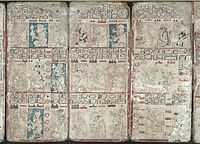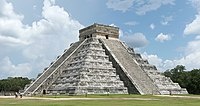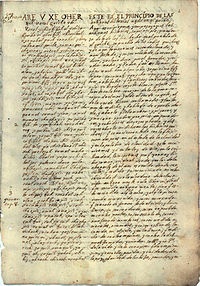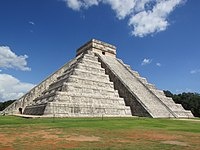-
Use Cases
-
Resources
-
Pricing
Early Mayan Civilization
Development of the Olmec Civilization
2000 BCE
% complete
The Olmec civilization, also known as the mother civilization of Mesoamerica, began to develop around 2000 BCE. They established complex societies with urban centers and developed key elements of Mesoamerican culture such as agriculture, writing, and a calendar system. The Olmec are known for their monumental stone heads and their influence on future civilizations in the region.
Rise of the Preclassic Period
2000 BCE
% complete
The Rise of the Preclassic Period marks the beginning of the Mayan civilization. During this time, small villages began to form and agricultural practices became more advanced. Trade networks also started to develop, allowing for the exchange of goods and ideas. This period laid the foundation for the later development of the Mayan city-states.
Image source: Preclassic Maya

Development of Maya Hieroglyphic Writing
300 BCE
% complete
The Maya hieroglyphic writing emerged around 300 BCE and was used by the Maya civilization to record their history, rituals, and important events. The writing system consisted of a combination of logograms and phonetic signs that represented syllables or individual sounds. It was primarily carved in stone or painted on pottery, books, and other surfaces. The development of Maya hieroglyphic writing marked a significant advancement in the recording and preservation of knowledge for the Maya civilization.
Image source: Maya script

Construction of El Mirador
300 BCE
% complete
Construction of El Mirador is a significant event in the history of Maya civilization. El Mirador, located in present-day Guatemala, was one of the largest cities during the Preclassic period. Construction of El Mirador began in 300 BCE and continued for several centuries. The city was known for its massive architecture, including several monumental structures such as temples, pyramids, and palaces. The construction of El Mirador was a complex undertaking that required extensive labor and resources. It served as a political and economic center, attracting people from surrounding regions. The city eventually declined and was abandoned around 150 CE, but its ruins remain as a testament to the advanced civilization of the ancient Maya.
Image source: El Mirador

Mayan City-States and Politics
Emergence of Tikal as a Major City-State
200 CE
% complete
The emergence of Tikal as a major city-state is believed to have occurred around 200 CE. Tikal, located in present-day Guatemala, was one of the most powerful and influential cities in the Mayan civilization. It reached its peak during the Classic Period (250-900 CE), with a population estimated to be around 60,000. Tikal was renowned for its monumental architecture, including impressive temples and pyramids. The city controlled a large territory, engaged in trade with other cities, and had a complex political structure. The rulers of Tikal played a significant role in Mayan politics and warfare, and the city's influence extended beyond its borders. Tikal continued to prosper until its decline in the 10th century CE, after which it was abandoned and eventually swallowed by the surrounding jungle. Today, Tikal is a UNESCO World Heritage Site and a popular tourist destination, offering visitors a glimpse into the grandeur and sophistication of the ancient Mayan civilization.
Construction of Chichen Itza
600 CE
% complete
The construction of Chichen Itza, one of the most famous Mayan cities, starts around 600 CE. Chichen Itza becomes a vital center for political, economic, and cultural activity in the region.
Image source: Chichen Itza

Reign of Pakal the Great in Palenque
615 CE
% complete
Collapse of Teotihuacan
650 CE
% complete
The Collapse of Teotihuacan was a major event that occurred around 650 CE in Mesoamerican history. Teotihuacan was a powerful city-state in the central highlands of Mexico, known for its complex urban planning, impressive pyramids, and large population. However, around 650 CE, the city-state went through a period of decline and ultimately collapsed. The reasons for the collapse are still debated among scholars but may have included internal political unrest, environmental factors, or external invasions. The collapse of Teotihuacan had significant consequences for the region and marked the end of the Classic period of Mesoamerican civilization.
Image source: Teotihuacan

Mayan Religion and Cosmology
Development of the Long Count Calendar
700 CE
% complete
The Long Count Calendar is a system of counting days used by the ancient Maya civilization. It is based on a base-20 system, with each period of time represented by a specific unit: kin (1 day), uinal (20 days), tun (360 days), katun (7,200 days), and baktun (144,000 days). The Development of the Long Count Calendar occurred around 700 CE and allowed the Mayans to accurately record and track dates for events, rituals, and astronomical observations.
Ritual Ballgame Becomes Popular
800 CE
% complete
The Ritual Ballgame Becomes Popular - The ritual ballgame, known as pok-a-tok, becomes popular throughout the Mayan civilization. It is played in ceremonial ballcourts and has religious and political significance. The game involves two teams who try to score points by hitting a rubber ball with their hips, knees, and elbows into stone rings. The winners are often rewarded with prestigious titles or sacrifices to the gods.
Image source: Mesoamerican ballgame

Creation of the Popol Vuh
900 CE
% complete
The Popol Vuh is a sacred Mayan text that recounts the creation of the world and the history of the Mayan civilization. It was written in the Quiche language by Mayan scribes around 900 CE. The Popol Vuh provides insights into Mayan mythology, religion, and culture, and it is considered one of the most important literary works of the ancient Americas.
Image source: Popol Vuh

Mayan Cultural Achievements
Construction of Copan's Hieroglyphic Stairway
755 CE
% complete
The Construction of Copan's Hieroglyphic Stairway is completed in 755 CE. This monumental staircase is covered with hieroglyphic inscriptions that provide valuable information about the history, mythology, and rulers of Copan. The stairs are made up of more than 2,000 individual blocks, each of which is carved with intricate glyphs. The construction of the stairway demonstrates the artistic and architectural skills of the Mayans, as well as their advanced knowledge of hieroglyphic writing.
Image source: Copán

Flourishing of Mayan Architecture and Art
800 CE
% complete
The period from 800 CE is considered the peak of Mayan architecture and art. During this time, the Maya constructed large and elaborate buildings, such as temples, pyramids, palaces, and observatories. They also created intricate and detailed sculptures, pottery, and textiles. The artwork often depicted mythological and religious themes, as well as historical events and important figures. The Mayans used various materials and techniques in their art, including stone carving, stucco, painting, and weaving. The flourishing of Mayan architecture and art during this period reflects the advanced knowledge, creativity, and cultural significance of the Maya civilization.
Image source: Mesoamerican pyramids

Development of Mayan Mathematics and Astronomy
900 CE
% complete
The Mayans made significant advancements in mathematics and astronomy, developing a sophisticated number system with a concept of zero and positional notation. They accurately calculated complex astronomical cycles, such as the movements of planets and the cycles of the moon and sun. Their knowledge of astronomy influenced their religious beliefs and the construction of their cities and sacred sites.
Decline and End of the Mayan Civilization
Decline of Mayan City-States
900 CE
% complete
The decline of Mayan city-states marked the end of the Classic period of Mayan civilization. This decline was characterized by a gradual abandonment of major cities, a decline in population, and a lack of political and economic stability. The exact causes of the decline are still debated among scholars, but factors such as warfare, environmental degradation, and economic collapse are believed to have played a role. By 900 CE, most Mayan city-states had been abandoned, signaling the end of the Mayan civilization as a dominant force in Mesoamerica.
Arrival of the Toltecs in Mayan Territories
900 CE
% complete
The Toltecs, a powerful Mesoamerican civilization, arrive in Mayan territories around 900 CE. They bring with them new cultural influences and technologies, such as architectural styles and the use of metals. This event marks a significant period of interaction and exchange between the Mayans and the Toltecs.
Collapse of the Classic Period
1000 CE
% complete
The Collapse of the Classic Period refers to the decline and eventual fall of the Mayan civilization's most prosperous era, known as the Classic Period. It is believed to have occurred around 1000 CE. Several factors have been proposed as possible causes for the collapse, including environmental degradation, warfare, political instability, and social unrest.
Abandonment of Chichen Itza
1221 CE
% complete
The Abandonment of Chichen Itza is a historical event that occurred around 1221 CE. Chichen Itza was once a thriving Mayan city in the Yucatan Peninsula, but for unknown reasons, it was abandoned and left in ruins. The exact cause of the abandonment is still a subject of debate among archaeologists and historians. Some theories suggest that political strife, environmental factors, or a decline in trade may have contributed to its downfall. Regardless of the reason, the abandonment of Chichen Itza marked the end of its dominance as a political and cultural center in the Mayan civilization.
Spanish Conquest of Yucatan Peninsula
1527 CE
% complete
The Spanish Conquest of the Yucatan Peninsula was a series of military campaigns and expeditions carried out by Spanish conquistadors against the Maya civilization in the Yucatan Peninsula of present-day Mexico. The conquest began in 1527 and lasted for several decades, resulting in the colonization and eventual decline of the Maya civilization.
Destruction of Mayan Codices by Spanish
1562 CE
% complete
The Spanish conquistadors, led by Pedro de Alvarado, destroy a large number of Mayan codices in an effort to suppress indigenous culture and religion. This act greatly diminishes our understanding of Mayan history, language, and culture.
Image source: Maya codices

Key Facts
- The Mayan civilization flourished in Mesoamerica, primarily in what is now modern-day Mexico and Central America.
- Mayans developed a complex writing system using hieroglyphs and had a deep understanding of mathematics, astronomy, and the cycles of nature.
- The Mayans constructed impressive architectural structures such as pyramids, palaces, and temples.
- Their society was highly organized and included a ruling elite, skilled craftsmen, and a large agricultural workforce.
- The decline of the Mayan civilization is still a topic of debate among historians, but factors may have included warfare, environmental degradation, and political collapse.
Source
This Mayan Civilization timeline was generated with the help of AI using information found on the internet.
We strive to make these timelines as accurate as possible, but occasionally inaccurates slip in. If you notice anything amiss, let us know at [email protected] and we'll correct it for future visitors.
Create a timeline like this one for free
Preceden lets you create stunning timelines using AI or manually.
Customize your timeline with one of our low-cost paid plans
Export your timeline, add your own events, edit or remove AI-generated events, and much more
Free
$
0
free forever
No credit card required.
Basic
$
10
/month
billed annually
Cancel anytime.
Pro
$
16
/month
billed annually
Cancel anytime.
Common Questions
Can I cancel anytime?
Yes. You can cancel your subscription from your account page at anytime which will ensure you are not charged again. If you cancel you can still access your subscription for the full time period you paid for.
Will you send an annual renewal reminder?
Yes, we will email you a reminder prior to the annual renewal and will also email you a receipt.
Do you offer refunds?
Yes. You can email us within 15 days of any payment and we will issue you a full refund.
What if I have more questions?
Check out our pricing docs or send us an email anytime: [email protected].
